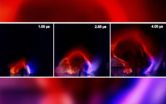(Press-News.org) NASA's Terra satellite captured the newest Typhoon in the western North Pacific Ocean, Tembin, as it moves parallel to Luzon, Philippines. Warm waters were the trigger in rapid intensification of the typhoon.
Typhoon Tembin grew from the fifteenth tropical depression over the weekend of August 18-19, and by Monday, August 20 was a powerful typhoon. At 5 a.m. EDT on August 20, forecasters at the Joint Typhoon Warning Center noted that Tembin "rapidly intensified over the past 24 hours" going from a 35-knot (40.2 mph/64.8 kmh) intensity on August 19 at 2 a.m. EDT to 95 knots (109.3 mph/175.9 kmh) on August 20 at 2 a.m. EDT.
When NASA's Terra satellite flew over Typhoon Tembin early on August 20, 2012 at 0235 UTC (10:35 a.m. local time Manila, Philippines/Aug. 19 10:35 p.m. EDT) the MODIS instrument (Moderate Resolution Imaging Spectroradiometer) captured a visible image of the storm. The 25 nautical-mile-wide (28.7 mile/46.3 km) eye was very clear and cloud free in the visible image.
The Joint Typhoon Warning Center noted that Tembin has maximum sustained winds near 95 knots (109.3 mph/175.9 kmh). At 0900 UTC (5 a.m. EDT/5 p.m. local time, Manila), Tembin was located 320 nm (368.2 miles/592.6 km) northeast of Manila, Philippines, near 18.7 North latitude and 124.9 East longitude. Tembin is moving slowly to the north-northeast at 4 knots (4.6 mph/7.4 kmh). It is expected to track north and then turn west, and head across Taiwan by August 23.
INFORMATION:
Typhoon Tembin forms fast in Philippines
2012-08-21
ELSE PRESS RELEASES FROM THIS DATE:
Speeding the search for better carbon capture
2012-08-21
A computer model that can identify the best molecular candidates for removing carbon dioxide, molecular nitrogen and other greenhouse gases from power plant flues has been developed by researchers with the U.S. Department of Energy (DOE)'s Lawrence Berkeley National Laboratory (Berkeley Lab), the University of California (UC) Berkeley and the University of Minnesota. The model is the first computational method to provide accurate simulations of the interactions between flue gases and a special variety of the gas-capturing molecular systems known as metal-organic frameworks ...
It's always sunny in Caltech Lab
2012-08-21
PASADENA, Calif.—In orbit around Earth is a wide range of satellites that we rely on for everything from television and radio feeds to GPS navigation. Although these spacecraft soar high above storms on Earth, they are still vulnerable to weather—only it's weather from the sun. Large solar flares—or plasma that erupts from the sun's surface—can cause widespread damage, both in space and on Earth, which is why researchers at the California Institute of Technology (Caltech) are working to learn more about the possible precursors to solar flares called plasma loops. Now, they ...
Sea life 'facing major shock'
2012-08-21
Life in the world's oceans faces far greater change and risk of large-scale extinctions than at any previous time in human history, a team of the world's leading marine scientists has warned.
The researchers from Australia, the US, Canada, Germany, Panama, Norway and the UK have compared events which drove massive extinctions of sea life in the past with what is observed to be taking place in the seas and oceans globally today.
Three of the five largest extinctions of the past 500 million years were associated with global warming and acidification of the oceans – trends ...
Marine species at risk unless drastic protection policies put in place
2012-08-21
LIVERMORE, Calif. -- Many marine species will be harmed or won't survive if the levels of carbon dioxide continue to increase.
Current protection policies and management practices are unlikely to be enough to save them. Unconventional, non-passive methods to conserve marine ecosystems need to be considered if various marine species are to survive.
This is the conclusion of a group of scientists led by University of California, Santa Cruz researcher and Lawrence Livermore National Laboratory visiting scientist Greg Rau, and includes Elizabeth McLeod of The Nature Conservancy ...
Intense bursts of star formation drive fierce galactic winds
2012-08-21
Fierce galactic winds powered by an intense burst of star formation may blow gas right out of massive galaxies, shutting down their ability to make new stars.
Sifting through images and data from three telescopes, a team of astronomers found 29 objects with outflowing winds measuring up to 2,500 kilometers per second, an order of magnitude faster than most observed galactic winds.
"They're nearly blowing themselves apart," said Aleksandar Diamond-Stanic, a fellow at the University of California's Southern California Center for Galaxy Evolution, who led the study. "Most ...
Halo of neutrinos alters physics of exploding stars
2012-08-21
Sparse halos of neutrinos within the hearts of exploding stars exert a previously unrecognized influence on the physics of the explosion and may alter which elements can be forged by these violent events.
John Cherry, a graduate student at UC San Diego, models stellar explosions, including a type called a core-collapse supernova. As these stars run out of fuel, their cores suddenly collapse to form a neutron star, which quickly rebounds sending seas of neutrinos through the surrounding stellar envelope and out into space.
Even as the collapsed core is rebounding, the ...
WiggleZ confirms the big picture of the Universe
2012-08-21
We know that stars group together to form galaxies, galaxies clump to make clusters and clusters gather to create structures known as superclusters. At what scale though, if at all, does this Russian doll-like structure stop? Scientists have been debating this very question for decades because clustering on large scales would be in conflict with our 'standard model' of cosmology. The current model is based on Einstein's equations assuming everything is smooth on the largest scales. If matter were instead clumpy on very large scales, then the entire model would need to be ...
'CSI' technology holds potential in everyday medicine
2012-08-21
PHILADELPHIA, Aug. 21, 2012 — A scientific instrument featured on CSI and CSI: Miami for instant fingerprint analysis is forging another life in real-world medicine, helping during brain surgery and ensuring that cancer patients get effective doses of chemotherapy, a scientist said here today.
The report on technology already incorporated into instruments that miniaturize room-size lab instrumentation into devices the size of a shoebox was part of the 244th National Meeting & Exposition of the American Chemical Society, the world's largest scientific society. The meeting, ...
New version of 150-year-old law could ease student debt and college funding cutbacks
2012-08-21
PHILADELPHIA, Aug. 21, 2012 — Members of a panel today commemorating the 150th anniversary of federal legislation that transformed college education for people in the 19th and 20th centuries said that a 21st century counterpart to the Morrill Act of 1862 could ease the staggering load of student debt and help colleges and universities cope with state funding cutbacks.
"A 21st century Morrill Act would be a wonderful symbolic and tangible move toward reinvesting in public higher education," Amy Bix, Ph.D., said in an interview prior to her presentation at the 244th National ...
In your future: More healthful foods to nourish the non-human you
2012-08-21
PHILADELPHIA, Aug. 21, 2012 — The focus of nutrition for good health is quietly shifting to include consumption of food ingredients specifically designed to nourish the non-human cells that comprise 80 percent of the cells in the typical person, an authority on the topic said here today.
Speaking at the 244th National Meeting & Exposition of the American Chemical Society, the world's largest scientific society, Robert Rastall, Ph.D., cited several factors driving these so-called "prebiotic" ingredients toward more foods. Food scientists, for instance, are developing new ...


